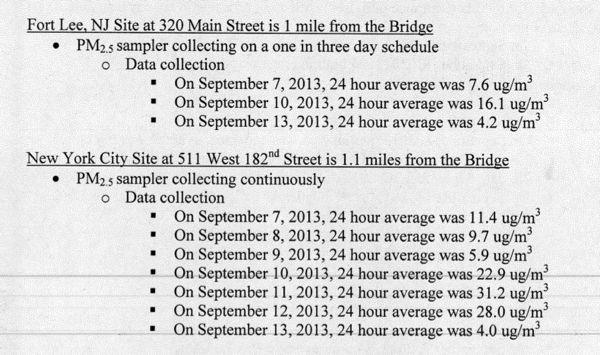According to EPA Data, Fine Particulate Pollution Levels in Ft. Lee NJ More than Doubled During Bridgegate
EPA Response to PEER IG Request Failed To Report Ozone Levels
This is no conspiracy theory
There’s a lot of pushback against Christie critics going on along various fronts – after repeated attempts to suggest bias (or worse) in order to discredit Legislative investigations (that’s why Assemblywoman Bonnie Watson Coleman resigned so quickly from the Committee after her remarks that Christie should resign), it appears that a far more aggressive rhetorical pattern is emerging.
The general idea is that critics are “deranged” by Bridgegate and engaging in “conspiracy theories” and “paranoid” “X-File” pure political attacks.
This “debunking” “conspiracy theory” spin is a Christie construct, designed to portray critics as “delusional” and “paranoid” in order to discredit them.
I see the origin of this pushback theme in the rumor that the Governor flew over the GW Bridge in the helicopter on 9/11/13.
The recent GWB air monitoring story followed a similar media trajectory.
Just days ago, we saw that happen again when DEP Press Office spokesman and former Star Ledger reporter Larry Ragonese used those tactics when he called critics of the Administration’s Hazard Mitigation Energy Grant program “X-Files” and “paranoid”.
And yesterday, Politico nationalized that Christie pushback meme in this story: EPA debunks one Bridgegate conspiracy.
Since I was the originator of two of these stories, I want to make a few points on the GWB air monitoring story (I already responded to the HMPG pushback in this post).
One of the objectives of our request to the EPA Inspector General to investigate why a NJ air monitoring station in Jersey City was not functioning during 3 days during Bridgegate was to put the issue of air quality impacts and the adequacy of the air monitoring network on the scandal consumed media radar and to build public awareness around these issues (when was the last media coverage of the details on the air monitoring network?)
DEP’s Ragonese disparages and dismisses this as “glomming on to scandal”.
But take a look at the data table above. [We would not have it assembled by EPA if PEER didn’t initiate the IG review.]
Fine particulate air quality levels in Ft. Lee more than doubled during Bridge-gate – from 7.6 ug/m(3) on Saturday September 7 to 16.1 ug/m(3) on Tuesday September 10 (levels in NY increased even more). Levels declined after Bridge-gate ended (Thursday) as measured on Friday 9/13 (in both NY and NJ – showing how commuter traffic impacts air pollution).
That Ft. Lee monitoring station’s data that EPA provided in response to our IG request is not available on the DEP’s website “multi-station Report”), so there was no way that I could be aware of it (thus our error on the claim that the Jersey City station was “closest).
And that data does not report ambient ground level ozone levels, the air people walking and stuck in traffic were breathing.
I guarantee levels were unhealthy, because: a) mobile source emissions (cars and trucks) emit ozone precursors. Traffic dramatically increases emissions; b) it was sunny and hot during the week on September 9, 2013; c) ozone forms in the presence of sunlight and heat; and d) NJ does not comply with the EPA ground level ozone standard during the summer.
- Conclusions
1. Bridgegate contributed to air pollution and had adverse health effects on the people stuck in traffic and on the street.
That is a fact – why can’t EPA just say that traffic causes air pollution – and because Bridgegate worsened traffic it made air pollution worse? Or would that be straying too far beyond the narrow confines of the IG review request?
2. The EPA and DEP air monitoring network is not able to measure local “hot spot” conditions – i.e. the real world – street level where people breath the air.
3. The EPA response did not report trend conditions – and relied on the NAAQS as the benchmark, not fluctuations that may have been caused by or related to Bridgegate traffic.
4. The EPA response provided no explanation of analysis of why the DEP Jersey City station was down (and did not discuss the significance of the fact that that station only monitors PM 2.5, not ozone).
5. Unfortunately, EPA’s response to PEER’s IG review request narrowly focused on the PM 2.5 and Jersey City air monitoring station, and thereby ignored all these issues.
And that’s no conspiracy theory – it’s regulatory politics as usual.

test
test 2